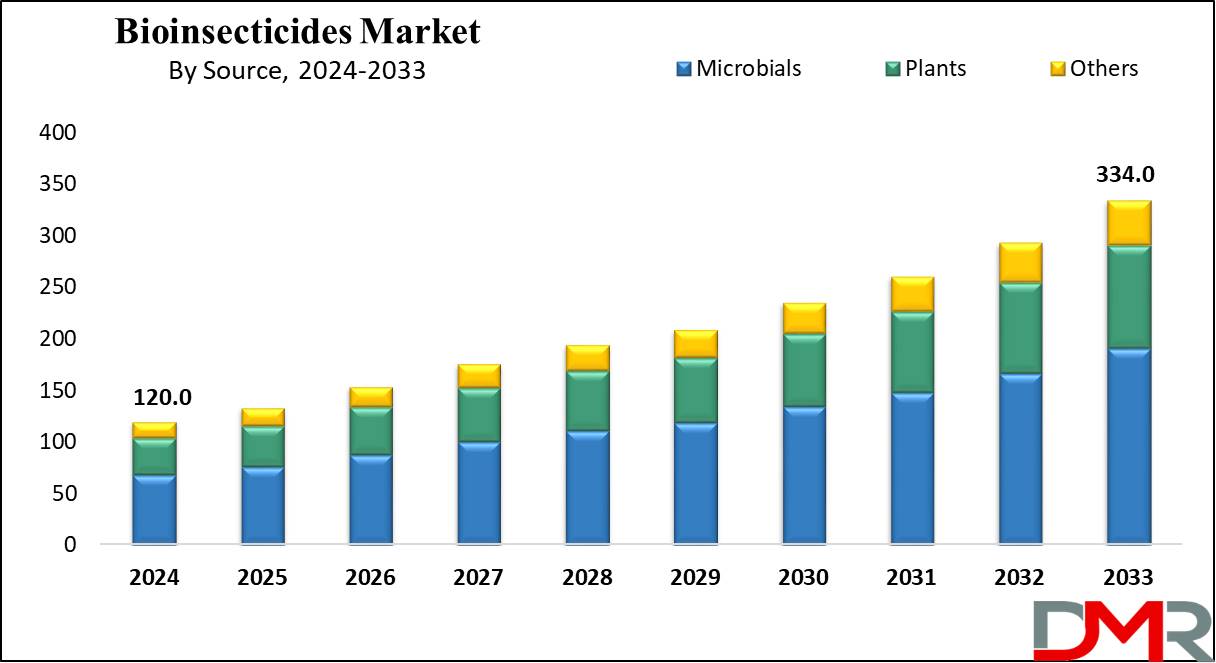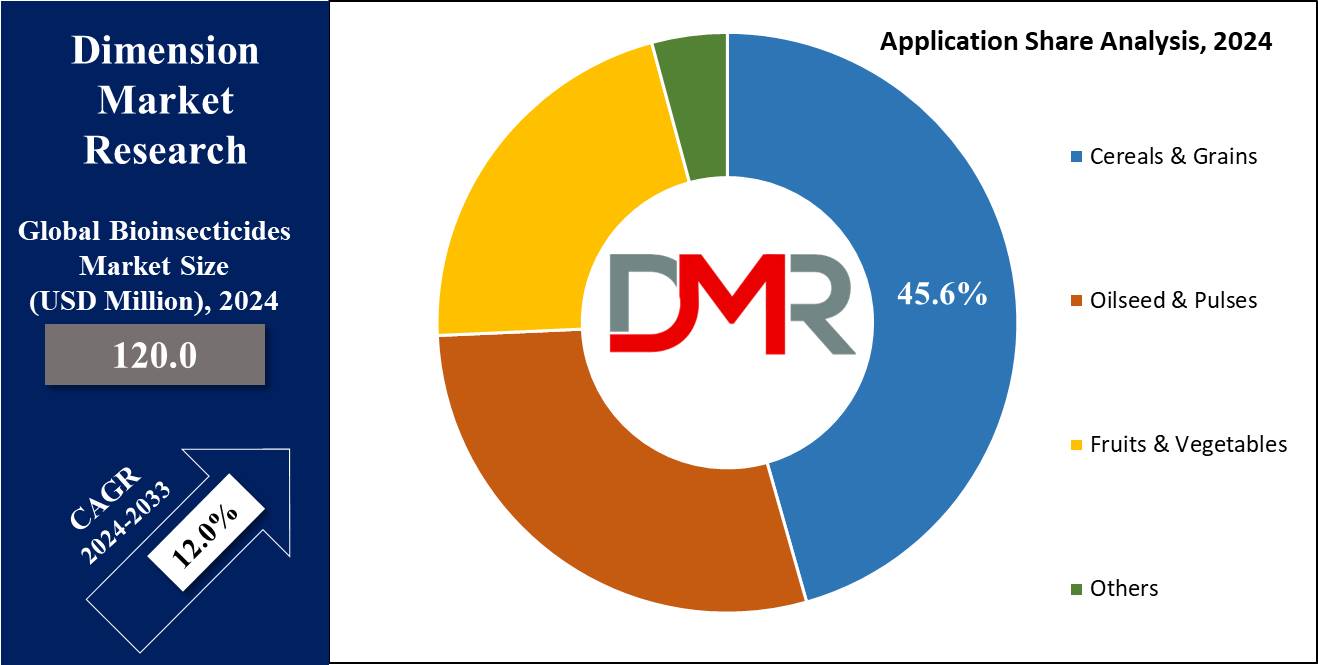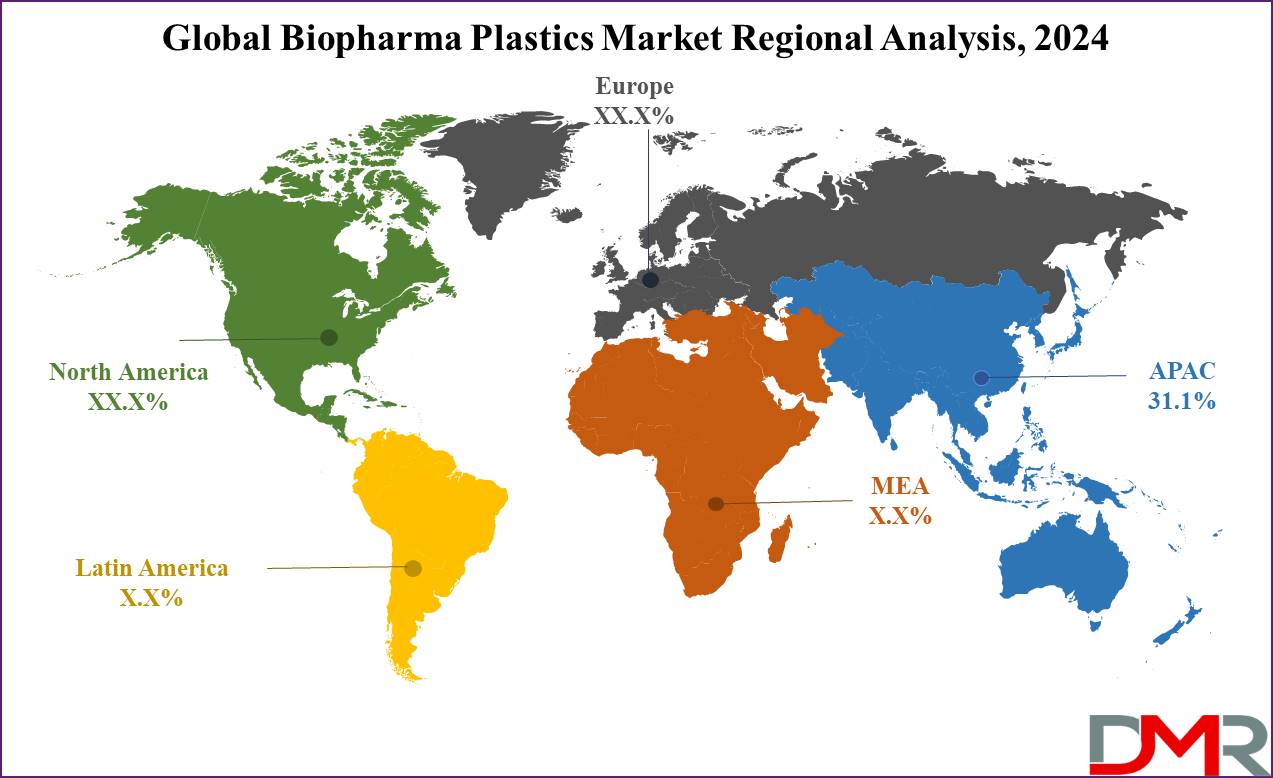Biological insecticides, or biopesticides, are naturally occurring substances that serve as insecticides to control or kill insect pest species. Insecticides are one of the types of pesticides, which are substances utilized to control or kill different types of pests. As they are obtained from organisms like plants, bacteria, and other microbes, fungi, nematodes, etc. They are components of integrated pest management (IPM) programs and have gained much practical attention as substitutes for synthetic Crop Protection Chemicals (PPPs).

Bioinsecticides market is rapidly advancing, driven by consumer desire for sustainable agricultural practices and organic food products. Recent developments include major investments to expand production capacity and develop novel formulations - for instance Corteva Agriscience's acquisition of Symborg marks its strategic expansion within biologicals while SOLASTA Bio's innovative peptide-based products are undergoing successful trials that demonstrate efficacy as well as pollinator safety.
Bioinsecticide adoption has increased due to issues like pest resistance to synthetic chemicals and regulatory pressure against chemical residues. Key opportunities lie in adopting eco-friendly technologies and expanding product usage on high-value crops like fruits and vegetables. While North America remains the primary market, Asia-Pacific is emerging as a strong growth hub, driven by increased organic farming and
Agriculture Biotechnology innovations.
Innovations in bioinsecticides include solutions tailored specifically for particular pests and ecosystems. Field trials conducted across Europe and North America demonstrate promising results in pest control without harming beneficial insects - something in line with global trends that prioritize environmental conservation while supporting agricultural productivity. With research progressing further, the market could eventually embrace these green technologies widely.
Bioinsecticides have experienced rapid development both in terms of production and adoption metrics. Globally, bioinsecticides are applied on over 10 million acres of farmland every year with usage increasing by 15% year-on-year in key agricultural economies such as the U.S. 75% of bioinsecticide applications targeting high value crops like fruits and vegetables which dominate export markets such as Europe or North America are targeted with bioinsecticide applications.
Environmentally speaking, bioinsecticides have demonstrated their worth by contributing to a decrease of up to 30% in pesticide residues on treated crops - directly benefiting pollinator populations and supporting pollinator health. Studies also show that regions using bioinsecticides experienced up to 40% fewer resistant pest outbreaks when compared with conventional methods; with growing adoption of Integrated Pest Management practices boosting bioinsecticide efficiency by 20% making bioinsecticides the go-to choice for sustainable farming practices and
Health and Wellness focused agriculture.
Key Takeaways
- Market Growth: The Bioinsecticides Market size is expected to grow by 210.0 million, at a CAGR of 12.0% during the forecasted period of 2025 to 2033.
- By Source: The microbial segment as s polymer is expected to lead in 2024 with a major & is anticipated to dominate throughout the forecasted period.
- By Application: Cereals & grains are expected to get the largest revenue share in 2024 in the Bioinsecticides market.
- Regional Insight: North America is expected to hold a 37.8% share of revenue in the Global Bioinsecticides Market in 2024.
- Use Cases: Some of the use cases of Bioinsecticides include Crop Protection, Organic Farming, and more.
Use Cases
- Crop Protection: Bioinsecticides are used to protect crops from pest damage, providing an eco-friendly alternative to chemical pesticides. They target specific pests while reducing harm to beneficial organisms and the environment.
- Resistance Management: Bioinsecticides play an important role in integrated pest management strategies, assisting to battle pest resistance that can develop against chemical pesticides. Their numerous modes of action provide farmers with effective tools to manage pest populations sustainably.
- Organic Farming: In organic farming systems, bioinsecticides are important tools for pest control, aligning with the principles of environmental stewardship and consumer requirements for pesticide-free produce.
- Public Health: Bioinsecticides are also used in public health efforts to restrict disease-carrying vectors like mosquitoes and ticks, supporting the reduction in the spread of diseases like malaria and Lyme disease while reducing harm to non-target organisms and ecosystems.
Market Dynamic
Driving Factors
Environmental Concerns
Major awareness of environmental issues and the negative impacts of chemical pesticides on ecosystems & human health is a major driver for the bioinsecticides market. Consumers & regulatory bodies are highly demanding sustainable agricultural practices, driving the adoption of bioinsecticides as safer alternatives.
Regulatory Support
Strict regulations on chemical pesticides, focused on reducing their environmental and health risks, are providing a conducive regulatory environment for the growth of the bioinsecticides market. Governments across the world are implementing policies to promote the use of bio-based and organic agricultural inputs, driving market expansion & promoting innovation in bioinsecticide development.
Restraints
Limited Efficacy
While bioinsecticides provide eco-friendly alternatives to chemical pesticides, they often lack efficacy in comparison to their synthetic counterparts, which can create a challenge in situations where rapid and complete pest control is needed, mainly in large-scale commercial farming operations.
High Costs
Bioinsecticides can be more expensive to produce than chemical pesticides, mainly due to the complexities of sourcing & processing natural ingredients, which can impact the adoption, mainly among smallholder farmers with limited budgets, and may affect the broader use of bioinsecticides in certain regions or crop systems.
Opportunities
Increasing Demand for Organic Products
The main consumer preference for organic and pesticide-free food products provides a major opportunity for the bioinsecticides market. As consumers become more conscious of health & environmental issues, there is a growth in demand for agricultural products grown using sustainable and eco-friendly methods, driving the adoption of bioinsecticides.
Technological Advancements
Current developments in biotechnology and microbial research are improving the effectiveness and versatility of bioinsecticides. Innovations like genetic engineering & formulation enhancements are expanding the range of pests targeted and improving the persistence & stability of bioinsecticide products, creating new opportunities for market growth and diversification
Trends
Microbial Bioinsecticides Dominance
Current trends show a shift towards microbial-based bioinsecticides, mainly those derived from bacteria and fungi. These products are gaining mainly due to their specificity, efficacy, & lower risk of resistance development in comparison to botanical or biochemical alternatives.
Integration of Biotechnology
The integration of biotechnology techniques like genetic engineering & fermentation processes is a major trend in the bioinsecticides market. These developments allow the development of genetically modified organisms (GMOs) with better insecticidal properties and the production of bioinsecticides at scale, driving efficiency & innovation in pest management solutions.
Research Scope and Analysis
By Source
Microbial as a source is projected to dominate the bioinsecticides market, marked with the maximum share in 2024, which can be mainly due to the broad range of pests it can target and its efficiency in comparison to other kinds of insecticides. Microbial insecticides are obtained from living microbes like bacteria, fungi & viruses. They work by infecting & killing mainly target pests while causing no or less harm to other organisms.
Among the high usage of microbial insecticides, Bacillus thuringiensis (Bt) comes out as a prominent example, which produces a protein toxic to insects like caterpillars & mosquitoes, providing an eco-friendly, efficient, & sustainable approach to controlling pests. Bt has also found numerous applications in organic farming for many years.
Also, that is widely used is Beauveria bassiana, a fungus that effectively eliminates soil-dwelling pests like ants, termites, & beetles. Moreover, Metarhizium anisopliae, another fungus, is used to control pests like grasshoppers & locusts. These microbial sources provide environmentally friendly options for the management of pests, acting the growing need for sustainable & ecologically sound pest control measures.
By Application
In terms of application, the bioinsecticides market is said to be led by cereals and grains, with a maximum revenue share in 2024, which can be accredited to the growth in the intake of cereals & grains, like barley, rice, oats, corn, wheat, & sorghum, because of their nutritional advantages. The segment of cereals and grains is also expected to dominate the market share for bioinsecticides, mainly due to the wide cultivation of wheat & corn in areas like the United States & China. In North America & Asia Pacific, bioinsecticides find their application in preserving cereals & grains, providing the cultivation of these crops on a larger scale.

Moreover, the bioinsecticides market is expected to gain from the growing focus of farmers on the production of oilseeds. Pulses & oilseeds comprise a range of seeds, like soybean, sunflower seeds & leguminous seeds (pulses), which also promote the growth of the market.
The Bioinsecticides Market Report is segmented on the basis of the following
By Source
By Application
- Fruits & Vegetables
- Oilseed & Pulses
- Cereals & Grains
- Others
Regional Analysis
North America is set to dominate the bioinsecticides market, commanding a maximum
share of 37.8% in 2024, which can be said due to the region's growing demand for eco-friendly & sustainable pest management practices. Moreover, North America has various key players working on the development & production of Bioinsecticides. These key players are aiming at developing improved & new products that are not only more useful but also user or eco-friendly.

Furthermore, the Organization for Economic Co-operation and Development (OECD) reported that Asia Pacific emerges as the topmost producer of agricultural goods, and is expected to hold a share of 53% of the overall output of agricultural goods by 2030. Facing a reduction in arable land & escalating food needs due to the growth of the population, farmers are utilizing bioinsecticides to boost crop yields, as the region has abundant raw materials & cheap labor, developing an environment that is favorable for agricultural activities.
However, the area also experiences some issues like scarcity of water, changes in climate, & degradation of land, resulting in major problems for the agricultural sector. In some countries like Sri Lanka, & Nepal, an unsanitary situation causes severe attacks on crops by various organisms, improving the desire for bioinsecticides as a real solution to deal with such pests.
By Region
North America
Europe
- Germany
- The U.K.
- France
- Italy
- Russia
- Spain
- Benelux
- Nordic
- Rest of Europe
Asia-Pacific
- China
- Japan
- South Korea
- India
- ANZ
- ASEAN
- Rest of Asia-Pacific
Latin America
- Brazil
- Mexico
- Argentina
- Colombia
- Rest of Latin America
Middle East & Africa
- Saudi Arabia
- UAE
- South Africa
- Israel
- Egypt
- Rest of MEA
Competitive Landscape
The bioinsecticides market is growing rapidly due to the higher demand for sustainable agriculture solutions, which are characterized by various products derived from natural organisms like bacteria, fungi, and plant extracts. Major driving factors like an increase in awareness of environmental issues and strict regulations on chemical pesticides. The market is highly competitive with many players investing heavily in R&D to innovate and enhance product efficacy.
In addition, partnerships &collaborations are common strategies to expand market presence and improve distribution networks. Overall, the switch towards organic farming and integrated pest management practices continues to fuel market expansion and diversification.
Some of the prominent players in the Global Bioinsecticides Market are
- Valent Biosciences Corporation
- Certis USA L.L.C.
- Novozymes
- Syngenta
- Nufarm
- BASF SE
- Bayer AG
- Marrone Bio Innovations
- Koppert Biological Systems
- BioWorks
- Vestaron Corporation
- Other Key Players
Recent Developments
- In May 2024, Vittia, launched its new bioinsecticide, IZATURBO, during Agrishow 2024, one of the largest agricultural fairs in Brazil, which was attended by AgroPages. Further it is formulated from the exclusive strain, BV14, of the entomopathogenic fungus, 𝐼𝑠𝑎𝑟𝑖𝑎 𝑗𝑎𝑣𝑎𝑛𝑖𝑐𝑎 (𝐶𝑜𝑟𝑑𝑦𝑐𝑒𝑝𝑠 𝑗𝑎𝑣𝑎𝑛𝑖𝑐𝑎). According to the manufacturer, it is a bio-input ″developed with cutting-edge technology to meet the increasing need for sustainable products, as it uses raw materials that do not leave residues in food and do not pose contamination risks to the environment.
- In April 2024, Bayer announced that the company signed an agreement with UK-based company AlphaBio Control to get a special license for a new biological insecticide. The new product will be the first available for arable crops, including oilseed rape and cereals. Targeted for initial launch in 2028 pending further development and registration, this new insecticide was discovered by AlphaBio, with whom Bayer distributes FLiPPER an award-winning bioinsecticide-acaricide.
- In February 2024, Syngenta Crop Protection and Lavie Bio Ltd agreed to the discovery & development of new biological insecticidal solutions. The collaboration will use Lavie Bio’s unique technology platform to rapidly identify & optimize bioinsecticide candidates, as well as Syngenta’s large global research, development, and commercialization capabilities.
- In January 2024, UPL launched bioinsecticide, Tackler, which includes the fungus, Beauveria bassiana. Further, Trackeler is a new solution for controlling pests that affect many crops. The strain used in the formulation was developed by a research institute and has been highly studied, showing "excellent results in the field."
Report Details
|
Report Characteristics
|
| Market Size (2024) |
USD 120.0 Mn |
| Forecast Value (2033) |
USD 334.0 Mn |
| CAGR (2024-2033) |
12.0% |
| Historical Data |
2018 – 2023 |
| Forecast Data |
2024 – 2033 |
| Base Year |
2023 |
| Estimate Year |
2024 |
| Report Coverage |
Market Revenue Estimation, Market Dynamics, Competitive Landscape, Growth Factors and etc. |
| Segments Covered |
By Source (Plants, Microbials, and Others), and By Application (Fruits & Vegetables, Oilseed & Pulses, Cereals & Grains, and Others). |
| Regional Coverage |
North America – The US and Canada; Europe – Germany, The UK, France, Russia, Spain, Italy, Benelux, Nordic, & Rest of Europe; Asia- Pacific– China, Japan, South Korea, India, ANZ, ASEAN, Rest of APAC; Latin America – Brazil, Mexico, Argentina, Colombia, Rest of Latin America; Middle East & Africa – Saudi Arabia, UAE, South Africa, Turkey, Egypt, Israel, & Rest of MEA |
| Prominent Players |
Valent Biosciences Corporation, Certis USAV L.L.C, Novozymes, Syngenta, Nufarm, BASF SE, etc., Bayer AG, Marrone Bio Innovations, Koppert Biological Systems, BioWorks, Vestaron Corporation, and Other Key Players |
| Purchase Options |
HVMN Inc., Thync Global Inc., Apple Inc., Fitbit Inc., TrackmyStack, OsteoStrong, The ODIN, Thriveport LLC, Muse, Moodmetric, and Other Key Players |